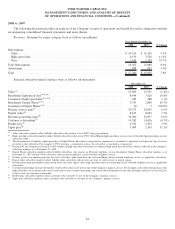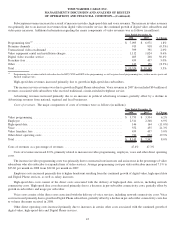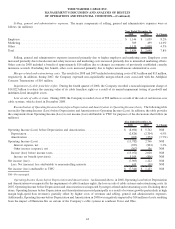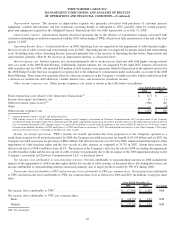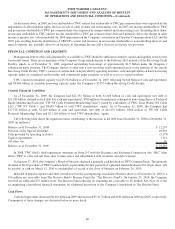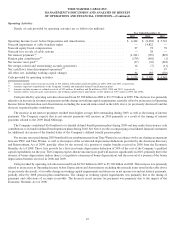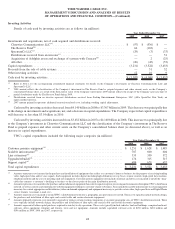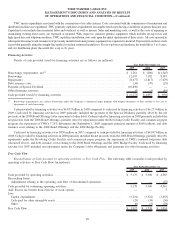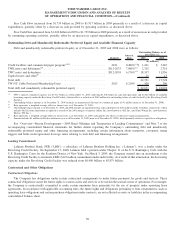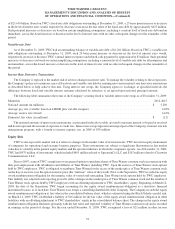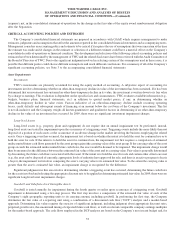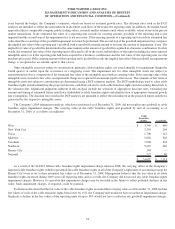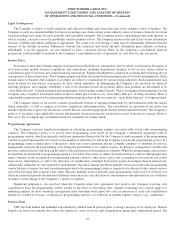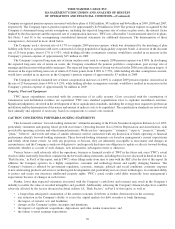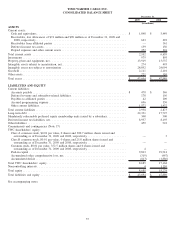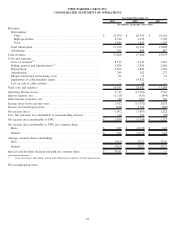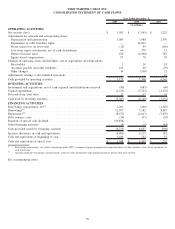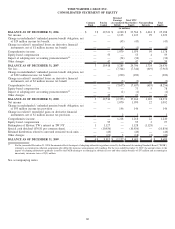Time Warner Cable 2009 Annual Report Download - page 64
Download and view the complete annual report
Please find page 64 of the 2009 Time Warner Cable annual report below. You can navigate through the pages in the report by either clicking on the pages listed below, or by using the keyword search tool below to find specific information within the annual report.of $23.639 billion. Based on TWC’s fixed-rate debt obligations outstanding at December 31, 2009, a 25 basis point increase or decrease
in the level of interest rates would, respectively, decrease or increase the fair value of the fixed-rate debt by approximately $427 million.
Such potential increases or decreases are based on certain simplifying assumptions, including a constant level of fixed-rate debt and an
immediate, across-the-board increase or decrease in the level of interest rates with no other subsequent changes for the remainder of the
period.
Variable-rate Debt
As of December 31, 2009, TWC had an outstanding balance of variable-rate debt of $1.261 billion. Based on TWC’s variable-rate
debt obligations outstanding at December 31, 2009, each 25 basis point increase or decrease in the level of interest rates would,
respectively, increase or decrease TWC’s annual interest expense and related cash payments by approximately $3 million. Such potential
increases or decreases are based on certain simplifying assumptions, including a constant level of variable-rate debt for all maturities and
an immediate, across-the-board increase or decrease in the level of interest rates with no other subsequent changes for the remainder of
the period.
Interest Rate Derivative Transactions
The Company is exposed to the market risk of adverse changes in interest rates. To manage the volatility relating to these exposures,
the Company’s policy is to maintain a mix of fixed-rate and variable-rate debt by entering into various interest rate derivative transactions
as described below to help achieve that mix. Using interest rate swaps, the Company agrees to exchange, at specified intervals, the
difference between fixed and variable interest amounts calculated by reference to an agreed-upon notional principal amount.
The following table summarizes the terms of the Company’s existing fixed to variable interest rate swaps as of December 31, 2009:
Maturities ................................................................................ 2012-2015
Notional amount (in millions) ................................................................. $ 5,250
Average pay rate (variable based on LIBOR plus variable margins) ...................................... 4.03%
Average receive rate (fixed) ................................................................... 6.24%
Estimated fair value (in millions) ............................................................... $ (12)
The notional amounts of interest rate instruments, as presented in the above table, are used to measure interest to be paid or received
and do not represent the amount of exposure to credit loss. Interest rate swaps represent an integral part of the Company’s interest rate risk
management program, with a benefit to interest expense, net, in 2009 of $30 million.
Equity Risk
TWC is also exposed to market risk as it relates to changes in the market value of its investments. TWC invests in equity instruments
of companies for operational and strategic business purposes. These investments are subject to significant fluctuations in fair market
value due to volatility in the general equity markets and the specific industries in which the companies operate. As of December 31, 2009,
TWC had $975 million of investments, which included $691 million related to SpectrumCo LLC and $207 million related to Clearwire
Communications LLC.
Prior to 2007, some of TWC’s employees were granted options to purchase shares of Time Warner common stock in connection with
their past employment with subsidiaries and affiliates of Time Warner, including TWC. Upon the exercise of Time Warner stock options
held by TWC employees, TWC is obligated to reimburse Time Warner for the excess of the market price of Time Warner common stock
on the day of exercise over the option exercise price (the “intrinsic” value of the award). Prior to the Separation, TWC recorded an equity
award reimbursement obligation for the intrinsic value of vested and outstanding Time Warner stock options held by TWC employees.
This liability was adjusted each reporting period to reflect changes in the market price of Time Warner common stock and the number of
Time Warner stock options held by TWC employees with an offsetting adjustment to TWC shareholders’ equity. Beginning on March 12,
2009, the date of the Separation, TWC began accounting for the equity award reimbursement obligation as a derivative financial
instrument because, as of such date, Time Warner is no longer a controlling shareholder of the Company. The Company records the equity
award reimbursement obligation at fair value in the consolidated balance sheet, which is estimated using the Black-Scholes model, and,
on March 12, 2009, TWC established a liability of $16 million for the fair value of the equity award reimbursement obligation in other
liabilities with an offsetting adjustment to TWC shareholders’ equity in the consolidated balance sheet. The change in the equity award
reimbursement obligation fluctuates primarily with the fair value and expected volatility of Time Warner common stock and is recorded
in earnings in the period of change. For the year ended December 31, 2009, TWC recognized a loss of $21 million in other income
52
TIME WARNER CABLE INC.
MANAGEMENT’S DISCUSSION AND ANALYSIS OF RESULTS
OF OPERATIONS AND FINANCIAL CONDITION—(Continued)


